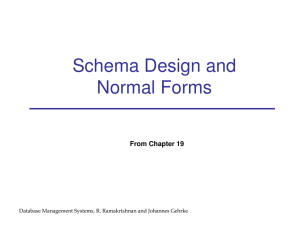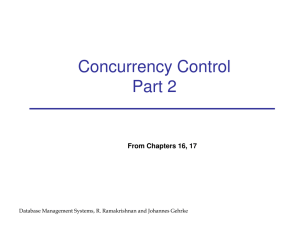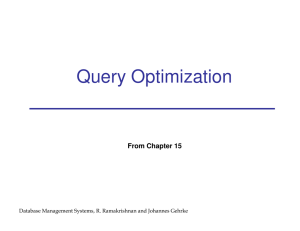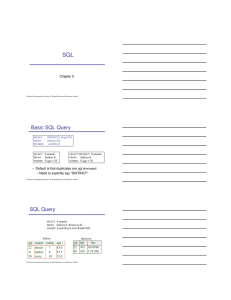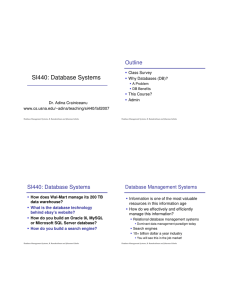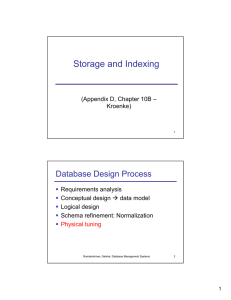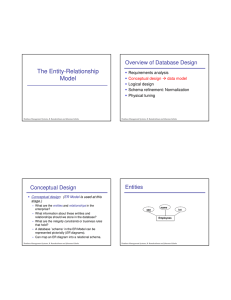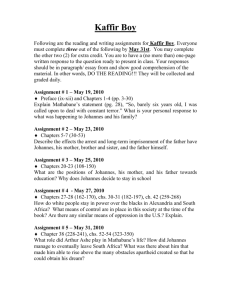Relational Algebra Relational Query Languages Chapter 4.1-4.2
advertisement
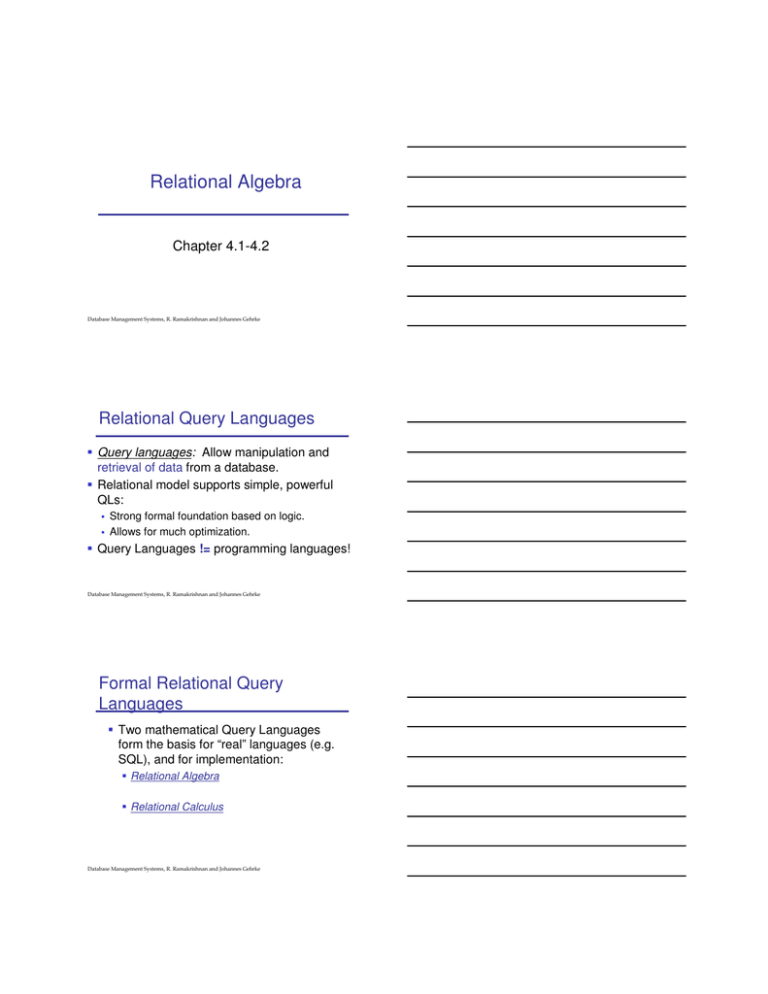
Relational Algebra
Chapter 4.1-4.2
Database Management Systems, R. Ramakrishnan and Johannes Gehrke
Relational Query Languages
Query languages: Allow manipulation and
retrieval of data from a database.
Relational model supports simple, powerful
QLs:
Strong formal foundation based on logic.
Allows for much optimization.
Query Languages != programming languages!
Database Management Systems, R. Ramakrishnan and Johannes Gehrke
Formal Relational Query
Languages
Two mathematical Query Languages
form the basis for “real” languages (e.g.
SQL), and for implementation:
Relational Algebra
Relational Calculus
Database Management Systems, R. Ramakrishnan and Johannes Gehrke
Preliminaries
A query is applied to relation instances,
and the result of a query is also a relation
instance.
Positional vs. named-field notation:
Database Management Systems, R. Ramakrishnan and Johannes Gehrke
Example Instances
R1 sid
22
58
bid
day
101 10/10/96
103 11/12/96
S1 sid
22
31
58
S2 sid
28
31
44
58
sname rating age
dustin
7
45.0
lubber
8
55.5
rusty
10 35.0
sname rating age
yuppy
9
35.0
lubber
8
55.5
guppy
5
35.0
rusty
10 35.0
Database Management Systems, R. Ramakrishnan and Johannes Gehrke
Relational Algebra
Basic operations:
Selection ( σ ) Selects a subset of rows from relation.
Projection (π ) Deletes unwanted columns from
relation.
Cross-product ( ) Allows us to combine two relations.
Set-difference ( ) Tuples in rel. 1, but not in rel. 2.
Union ( U ) Tuples in rel. 1 and in rel. 2.
×
−
Additional operations:
Intersection, join, division, renaming: Not essential, but
(very!) useful.
Database Management Systems, R. Ramakrishnan and Johannes Gehrke
Projection
Deletes fields that are not in projection list.
Result schema?
sname
Duplicates?
yuppy
lubber
guppy
rusty
S2 sid
28
31
44
58
rating
9
8
5
10
π sname,rating(S2)
sname rating age
yuppy
9
35.0
lubber
8
55.5
guppy
5
35.0
rusty
10 35.0
age
35.0
55.5
Database Management Systems, R. Ramakrishnan and Johannes Gehrke
π age(S2)
Selection
Selects rows that satisfy
selection condition.
Result schema?
Duplicates?
S2 sid
28
31
44
58
sname rating
yuppy 9
rusty
10
sid sname rating age
28 yuppy 9
35.0
58 rusty
10
35.0
σ rating >8(S2)
sname rating age
yuppy
9
35.0
lubber
8
55.5
guppy
5
35.0
rusty
10 35.0
π sname,rating(σ rating >8(S2))
Database Management Systems, R. Ramakrishnan and Johannes Gehrke
Union, Intersection, Set-Difference
All of these operations take
two input relations, which
must be union-compatible:
Same number of fields.
`Corresponding’ fields
have the same type.
Result schema?
sid sname
22 dustin
rating age
7
45.0
sid
s na m e
ra tin g
age
22
31
58
44
28
d u s tin
lu b b e r
ru s ty
guppy
yuppy
7
8
10
5
9
4 5 .0
5 5 .5
3 5 .0
3 5 .0
3 5 .0
S1∪ S2
sid
31
58
sn a m e
lu b b e r
ru sty
S1− S2
Database Management Systems, R. Ramakrishnan and Johannes Gehrke
r a t in g
8
10
S1∩ S2
age
5 5 .5
3 5 .0
Cross-Product
Each row of S1 is paired with each row of R1.
Result schema?
s id
S1 2 2
31
58
snam e
d u s tin
lu b b e r
ru sty
ra tin g
7
8
10
ag e
4 5 .0
5 5 .5
3 5 .0
R1 s i d
b id
101
103
22
58
(sid) sname rating age
day
1 0 /1 0 /9 6
1 1 /1 2 /9 6
(sid) bid
day
22
dustin
7
45.0
22
101
10/10/96
22
dustin
7
45.0
58
103
11/12/96
31
31
lubber
lubber
8
8
55.5
55.5
22
58
101
103
10/10/96
11/12/96
58
rusty
10
35.0
22
101
10/10/96
58
rusty
10
35.0
58
103
11/12/96
Renaming operator:
ρ (C(1→ sid1, 5 → sid 2), S1× R1)
Database Management Systems, R. Ramakrishnan and Johannes Gehrke
Joins
Condition Join: R >< c S = σ c ( R × S)
(sid) sname rating age
22
dustin 7
45.0
31
lubber 8
55.5
S1 ><
(sid) bid
58
103
58
103
S1. sid < R1. sid
day
11/12/96
11/12/96
R1
Result schema?
Fewer tuples than cross-product, might be able to
compute more efficiently
Sometimes called a theta-join.
Database Management Systems, R. Ramakrishnan and Johannes Gehrke
Joins
Equi-Join: A special case of condition join
where the condition c contains only
equalities.
sid
22
58
sname rating age
dustin 7
45.0
rusty
10
35.0
S1 ><
sid
bid
101
103
day
10/10/96
11/12/96
R1
Result schema?
Natural Join: Equijoin on all common fields.
Database Management Systems, R. Ramakrishnan and Johannes Gehrke
In Class Exercise
Find the name of sailors who have
reserved at least one boat
Find the sid of sailors who have reserved
at least two boats
Database Management Systems, R. Ramakrishnan and Johannes Gehrke
Division
Not supported as a primitive operator, but useful for
expressing queries like:
Find sailors who have reserved all boats.
Let A have 2 fields, x and y; B have only field y:
A/B = { x | ∀ y ∈ B ∃ x , y ∈ A }
i.e., A/B contains all x tuples (sailors) such that for
every y tuple (boat) in B, there is an xy tuple in A.
Or: If the set of y values (boats) associated with an x value
(sailor) in A contains all y values in B, the x value is in A/B.
In general, x and y can be any lists of fields; y is the
list of fields in B, and x ∪ y is the list of fields of A.
Database Management Systems, R. Ramakrishnan and Johannes Gehrke
Examples of Division A/B
sno
s1
s1
s1
s1
s2
s2
s3
s4
s4
pno
p1
p2
p3
p4
p1
p2
p2
p2
p4
A
pno
p2
B1
pno
p2
p4
B2
B3
sno
s1
s2
s3
s4
A/B1
pno
p1
p2
p4
A/B2
Database Management Systems, R. Ramakrishnan and Johannes Gehrke
A/B3
Expressing A/B Using Basic
Operators
Division is not essential op; just a useful shorthand.
Idea: For A/B, compute all x values that are not
`disqualified’ by some y value in B.
x value is disqualified if by attaching y value from B, we
obtain an xy tuple that is not in A.
Disqualified x values:
A/B:
π x ( A) −
all disqualified tuples
Database Management Systems, R. Ramakrishnan and Johannes Gehrke
Find names of sailors who’ve reserved
boat #103
Solution 1:
Solution 2:
Solution 3:
Database Management Systems, R. Ramakrishnan and Johannes Gehrke
Find names of sailors who’ve reserved
a red boat
Information about boat color only available
in Boats; so need an extra join:
Database Management Systems, R. Ramakrishnan and Johannes Gehrke
Find sailors who’ve reserved a red or a
green boat
Can identify all red or green boats, then find
sailors who’ve reserved one of these boats:
ρ (Tempboats, (σ
color =' red ' ∨ color =' green '
Boats))
π sname(Tempboats >< Re serves >< Sailors)
Can also define Tempboats using union! (How?)
What happens if ∨ is replaced by ∧ in this query?
Database Management Systems, R. Ramakrishnan and Johannes Gehrke
Find sailors who’ve reserved a red and a
green boat
Previous approach won’t work! Must identify
sailors who’ve reserved red boats, sailors
who’ve reserved green boats, then find the
intersection (note that sid is a key for Sailors):
Database Management Systems, R. Ramakrishnan and Johannes Gehrke
Find the names of sailors who’ve
reserved all boats
Use division:
Database Management Systems, R. Ramakrishnan and Johannes Gehrke
Summary
The relational model has rigorously
defined query languages that are simple
and powerful.
Relational algebra is more operational;
useful as internal representation for query
evaluation plans.
Several ways of expressing a given query;
a query optimizer should choose the most
efficient version.
Database Management Systems, R. Ramakrishnan and Johannes Gehrke
